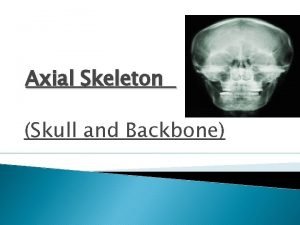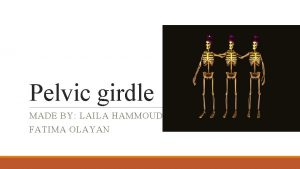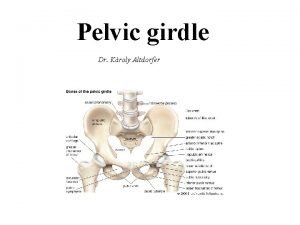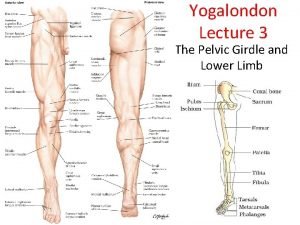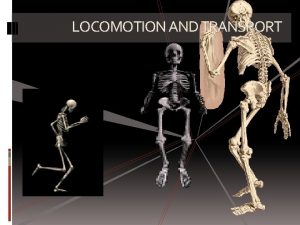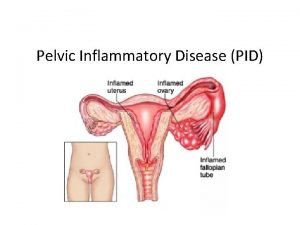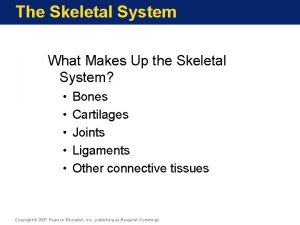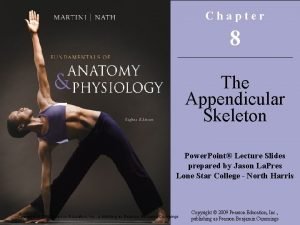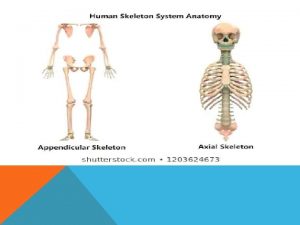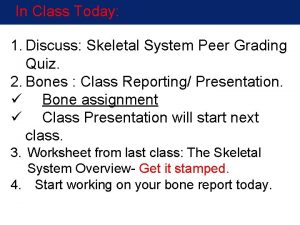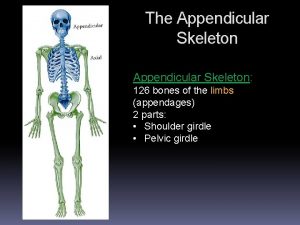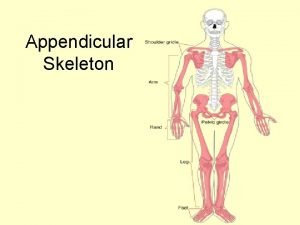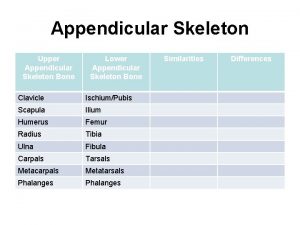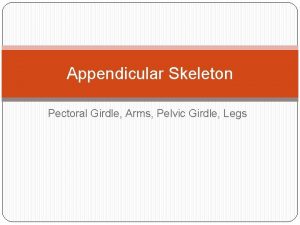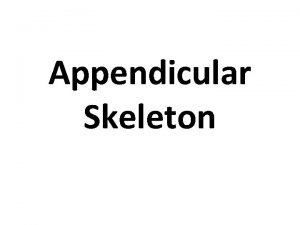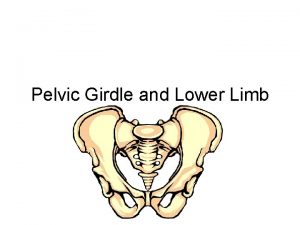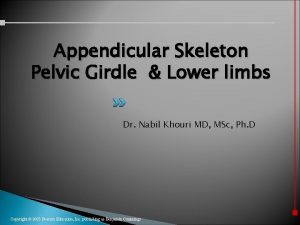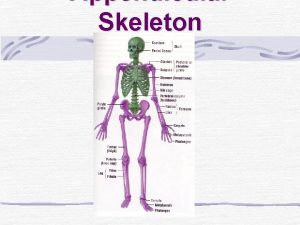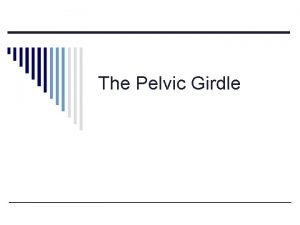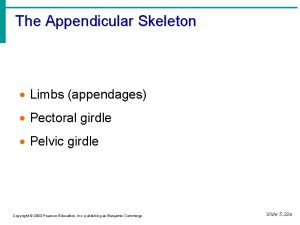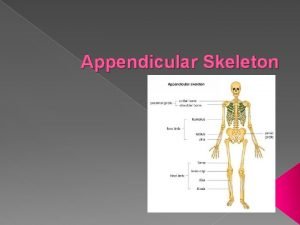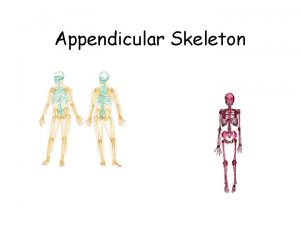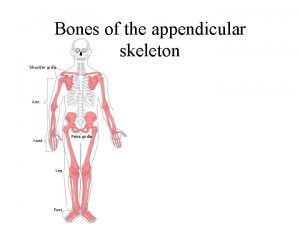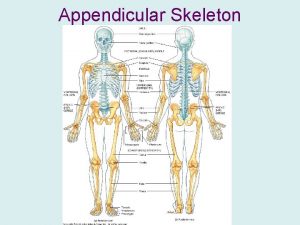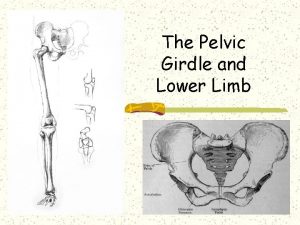Appendicular Skeleton Pelvic Girdle Thigh Leg Lower Leg
















- Slides: 16

Appendicular Skeleton • • • Pelvic Girdle Thigh (Leg) (Lower) Leg Foot The lower appendages are attached to the axial skeleton via the pelvic girdle

Bones of the Pelvic Girdle • Pelvic girdle 2 coxal bones + sacrum – Coxal bones are three pairs of fused bones 1. Ilium 2. Ischium 3. Pubis • Bony pelvis 2 coxal bones + sacrum + coccyx © 2015 Pearson Education, Inc.

Function of the Pelvic Girdle • protects several organs – Reproductive organs – Urinary bladder – Part of the large intestine • Bears weight of the upper body © 2015 Pearson Education, Inc.

Figure 5. 26 a The bony pelvis. Articulates with axial skeleton at the sacrum = sacroiliac joint Iliac crest Sacroiliac joint Ilium Coxal bone (or hip bone) Sacrum Pubis Pelvic brim Coccyx Ischial spine Acetabulum Ischium (a) Pubic symphysis Pubic arch

Figure 5. 26 b The bony pelvis. Ilium Ala Posterior superior iliac spine Posterior inferior iliac spine Greater sciatic notch Ischial body Ischial spine Ischial tuberosity Ischium (b) Ischial ramus Iliac crest Anterior superior iliac spine Anterior inferior iliac spine Acetabulum Body of pubis Pubis Inferior pubic ramus Obturator foramen

Gender Differences of the Pelvis • The female’s pelvis: – Inlet is larger and more circular – Pelvis as a whole is shallower, and the bones are lighter and thinner – Ilia flare more laterally – Sacrum is shorter and less curved – Ischial spines are shorter and farther apart; thus, the outlet is larger – Pubic arch is more rounded because the angle of the pubic arch is greater © 2015 Pearson Education, Inc.

Figure 5. 26 c The bony pelvis. False pelvis Inlet of true pelvis Pelvic brim Pubic arch (less than 90°) False pelvis Inlet of true pelvis Pelvic brim (c) Pubic arch (more than 90°)

Bones of the Lower Appendages • Femur—thigh bone – heaviest, strongest bone in the body – Proximally, the head articulates with the acetabulum of the (hip) bone • This creates a ball-and-socket joint – Distally, the lateral and medial condyles articulate with the tibia in the lower leg © 2015 Pearson Education, Inc.

Figure 5. 27 a Bones of the right thigh and leg. Neck Head Intertrochanteric line Lateral condyle Patellar surface (a) Lesser trochanter

Figure 5. 27 b Bones of the right thigh and leg. Greater trochanter Head Lesser trochanter Intertrochanteric crest Gluteal tuberosity Intercondylar fossa Medial condyle (b) Lateral condyle

Bones of the Lower Limbs 1. Tibia—shinbone; larger and medially oriented – Medial and lateral condyles articulate proximally with the femur to form the knee joint 2. Fibula—thin and sticklike; lateral to the tibia – Not part of the knee joint • (Patella- a sesamoid (short) bone that lies anteriorly in the knee joint; called kneecap) © 2015 Pearson Education, Inc.

Figure 5. 27 c Bones of the right thigh and leg. Intercondylar eminence Medial condyle Lateral condyle Head Tibial tuberosity Proximal tibiofibular joint Interosseous membrane Anterior border Fibula Tibia Distal tibiofibular joint Lateral malleolus (c) Medial malleolus

Bones of the Foot • Tarsals—Two largest tarsals • Calcaneus (heel bone) • Talus • Metatarsals—form the sole of the foot • Phalanges—form the toes – Big toe is the hallux – All have 3 bones; hallux has 2 © 2015 Pearson Education, Inc.

Figure 5. 28 Bones of the right foot, superior view. Phalanges: Distal Middle Proximal Tarsals: Medial cuneiform Intermediate cuneiform Navicular Metatarsals Tarsals: Lateral cuneiform Cuboid Talus Calcaneus

Arches of the Foot • Bones of the foot are arranged to form three strong arches – Two longitudinal • Medial and laterally located – One transverse © 2015 Pearson Education, Inc.

Figure 5. 29 Arches of the foot. Medial longitudinal arch Transverse arch Lateral longitudinal arch
 Pectoral girdle acetabulum
Pectoral girdle acetabulum Appendicular vs axial skeleton
Appendicular vs axial skeleton Appendicular vs axial
Appendicular vs axial Lumbocostal triangle
Lumbocostal triangle Lower extremity appendicular skeleton
Lower extremity appendicular skeleton Pelvic girdle
Pelvic girdle Pelvic girdle pain
Pelvic girdle pain Pelvis major minor
Pelvis major minor Muscles of the pelvic girdle
Muscles of the pelvic girdle Pain in shoulder blade
Pain in shoulder blade Concept map transport mechanism
Concept map transport mechanism Pelvic inflammatory disease
Pelvic inflammatory disease Figure 6-2 structure of a typical bone
Figure 6-2 structure of a typical bone Posterior view of patella
Posterior view of patella The appendicular skeleton includes
The appendicular skeleton includes Figure 6-4 the skeleton axial and appendicular divisions
Figure 6-4 the skeleton axial and appendicular divisions What are parts of the appendicular skeleton
What are parts of the appendicular skeleton


